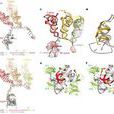在DNA分子的雙螺旋結構中,位於兩條多核苷酸鏈上的嘌呤鹼基和嘧啶鹼基可以圍繞著螺旋軸通過形成氫鍵而互相搭配成對,鹼基間這種形式的結合,就稱為鹼基配對..In the doublehelixstructure ofDNAmolecules, located in more than two purine nucleotide chain bases and pyrimidine bases can be around the screwaxisthrough the formation of hydrogenbonds with each other in pairs, this form of integration between bases on the is called base pairing. base pairing principles are: (1) purine and pyrimidine bases specifically base pairing, and adenine (A) specifically with thymine (T) pairs (in the RNA molecules, adenine College and uracil (U) pair); guanine (G) College and cytosine (C) pair. (2) four possible base pairs for the A-T, T-A, G-C and C-G.A , and T form two hydrogen bonds between, G, and C constitute the three hydrogen bonds between. four kinds of base pairs is almost the same size. (3) matching between the two bases are complementary, so that is conducive to hydrogen bond formation of the double helix structure has a stabilizing effect. the principle of base pairing of the semi-conservative DNA replication, has a special significance. It passed the stability of the genetic information provides a molecular basis. to ensure parental generation of the genetic information passed to the son of a complete generation, so that offspring receive parental genetic trait.

